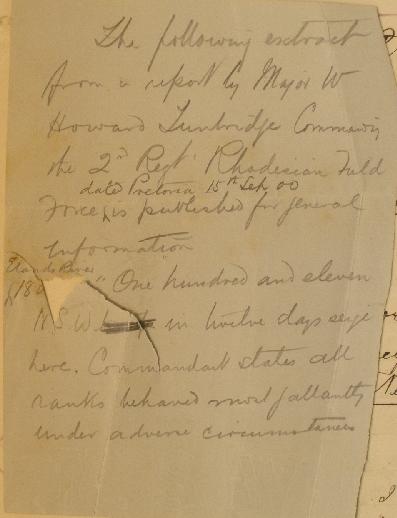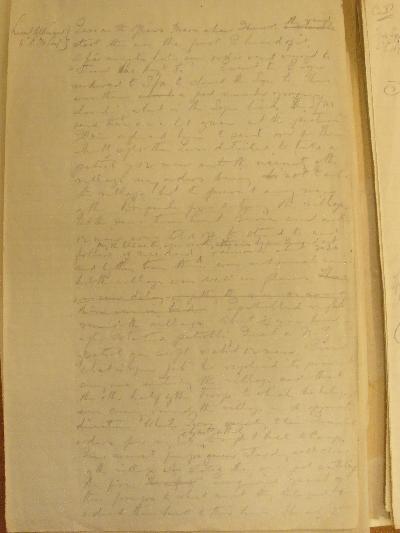(Extract from Manual of Military Cooking, 1895).
For Guidance of Quartermasters and Sergeant-cooks, and Quartermaster-Sergeants Acting.
N.B. The following instructions could be readily adopted to the conditions of outdoor life of the bushmen of Australia with advantage to the Military Force as well as the comfort of men in camp under any circumstances.
(1.) To cook rapidly and well is an art which can be easily acquired, and which every soldier should learn. Officers commanding should be responsible that there are a certain number of men (at least eight or ten) in each troop who have been instructed in the cutting up of meat, making field kitchens, and cooking. A sergeant-cook or regimental quartermaster-sergeant should be specially trained for the purpose of instructing men in this part of their duty. It is a matter of paramount necessity that soldiers' food should be carefully looked after, and this should be attended to by the officers themselves.
(2.) Service kettles are as follows:
| Name | weight | Contents | Surface Diameter | Depth Outside | With Vegetables | Without Vegetables |
| | lb. | Gallons. | in. x in. | inches. | Number of men | Number of men |
| Oval, large | 8 | 3 | 13½ x 9 | 11 | 8 | 15 |
| Oval, small | 4½ | 1¾ | 12½ x 8½ | 8 | 5 | 8 |
(3.) On arrival in camp the cooking party, consisting of the sergeant-cook, assistant-cook, two men per troop, will proceed to make the kitchen. If the encampment be only for one night, one trench per company should be dug 6 feet long 9 inches wide, and 18 inches deep at the mouth, and continued for 18 inches up the trench, then sloping upwards to 4 inches at the back, with a splay mouth pointing towards the wind 2 feet 6 inches by 3 feet 8 inches deep, and a rough chimney, 2 feet high, at the opposite end, and formed with the sods cut off the top of the trench. It will be advantageous if these trenches be cut on a gentle slope.
(4.) All brushwood and long grass should be carefully cut for a circle of 20 feet round the kitchen, and may be used in lighting the fire. On damp or marshy sites a wall trench will be found to answer best, constructed as follows:-
Cut some sods of turf about 18 inches long and 9 inches wide, and lay them in two parallel lines 6 feet long, with an interval between them of 2 feet 6 inches. Build these walls 2 feet High for the large kettles and 18 inches for the small ones. Lay the wood all over the bottom between the walls. Light the fire. This trench will hold twelve large or twenty small ones. It should be built sideways to the wind to prevent the flame and heat being carried through by the draught. If there be no time to dig a trench, or the ground be hard or sandy, the kettles may be placed in rows 10 inches apart, and the fires lighted between them, the heat being thus applied to the sides as well as the bottom. If necessary a row of kettles can be placed across the others over the fire. By this method, however, the cooking takes a little longer and more fuel, but the time required to construct the kitchen is saved. Troops should, in all circumstances, have their dinners an hour and a half after the rations are issued.
(5.) Another way is to have a hole prepared by forming a mound with stones, clay, or turf, and making a hollow in the centre the size of the kettle, in such a way as to allow only air enough to support combustion and prevent the escape of the heat.
(6.) The sergeant-cook (or regimental quartermaster-sergeant if no sergeant-cook available) will apportion the meat, potatoes, etc., to the various messes, which the cooks will cut up and place in the kettles.
(7.) Messes should be by kettles - that is, the number of men composing a mess should depend on the kettle used. Lighting the fires should be performed by a man used to the work. Small pieces of wood, about the size of lucifer matches, should be first ignited, and the fire gradually fed with larger ones. By this time the water party should have brought the requisite water in the camp kettles, and the moment the fire is well lighted the kettles should be laid on the trench and brought to a boil, after which allowed to simmer gently. The time from the opening of the ground until the water boils should not exceed thirty-five minutes. The water in which the potatoes are boiled should not be thrown away, as it is required for washing up. When the cooking is done for the day, kettles should be filled overnight with clean water and placed on the trenches and covered with turf, so that in the event of rain during the night the trenches and wood may be kept dry. In case the corps move away the cooks should light the fire thirty minutes before reveille, so that the water is boiling by the time it is sounding. The camp kettles should be delivered to the quartermaster by the assistant cooks of each company. Each cook to fill up the trench he dug. All offal and refuse that is not sold to be buried. All wood not used to be left in a heap on the ground. The sergeant cook on the line of march should always arrange to have a portion of dry wood carried from one camp to another for kindling purposes. Room can easily be found in the waggons to carry a small bungle of sticks; if not, each cook should carry enough small dry wood to light his own fire. This, will be found a great assistance in wet weather.
(8) If troops remain in camp more than a day or two it is advisable to build a regular field kitchen.
(9.) The gridiron kitchen (Aldershot pattern) consists of nine trenches 12 feet long, 9 inches wide, 18 inches deep at the mouth, this depth is carried for 18 inches inwards, and forms the fire-place, gradually diminishing to 6 inches where it enters the flue; they are connected by splay mouths 2 ft. by 2 ft., and 18 inches deep to the transverse trench, which is 36 feet long, 2 feet wide, and 21 inches deep.
(10.) The centre trench is connected with the chimney (6 feet high 3 feet square at the bottom, sloping gradually up to 2 feet square at the top) by a flue 12 feet long, 9 inches wide, and 6 inches deep, covered with the sods removed from the trenches.
(11.) To mark out the kitchen, drive a picket to mark the centre of the chimney, a second one 12 feet below, which will mark the top centre of the trench, the third one 12 feet below marking the bottom centre of the trench, the fourth one 2 feet below marks the centre of the splay mouth, and the fifth 2 feet below the outer edge of the transverse trench, for a single trench this would be 4 feet long. For each extra trench added a picket would be driven in 4 feet from each of the latter four pickets used in forming the centre or main trench, and parallel to it leaving after the excavations 3 ft. 3 in. for the cooks to work in, the top of each trench being attached to the chimney by a covered flue as shown in diagram.
(12.) Where it is possible to build the kitchen on a slope, flues are not required, the trench should be lengthened 1 foot, and a chimney about 2 feet high will be found sufficient to provide the draught and carry away the smoke.
(13.) Construction. - One man excavates each trench, commencing from the ends nearest the chimney, another man cuts out the bottom of the chimney, and builds it up with the sods cut in construction of the trenches. The third man excavates the draught or flue, which is 12 feet long, 9 inches wide, and 6 inches deep; and as soon as the trenches are dug, he cuts a line from the head of each into the main flue, taking care that the openings of the outer tunnels do not face one another (which would interfere with the proper working of the draught), then covers the flue with turf or sod from the top of the trenches to the chimney.
The other two men excavate the transverse trench, and provide turf for the construction of the chimney.
The men on the completion of the trenches are employed respectively in providing and mixing clay, carrying water, and covering the trenches for the reception of the kettles.
(14.) Great care must be taken in the construction of the chimney; all holes and interstices must be plastered with clay.
(15.) The insides off the trenches may be plastered with clay if it be plentiful. If this is done the dimensions should be slightly increased. If the clay is scarce the trenches should be cut smooth. Each trench will accommodate about eleven oval or twelve small oval kettles, the holes for which should be modelled in clay, using the base of a kettle as a mould. The intervals across the trench should be covered by sods placed grass side downwards, or stones, hoop-iron, sticks plastered with clay, and all interstices closed with clay or sods. This kitchen will last a fortnight even if not plastered with clay. Time required to construct eight hours, working party one non-commissioned officer and twelve men, tools required:
Axes, pick - 3
Hooks, bill - 2
Kettles, camp - 9
Pickets, bundle of - 1
Spades - 11
It will be seen that this kitchen admits of easy extension by the addition of more trenches.
(16.) Advantages - More room is provided between the trenches for the cooks to work in, less time is required to build. Eighteen feet less ground is required to provide this transverse trench, the flues are easy to repair.





